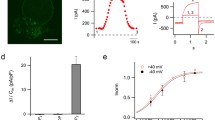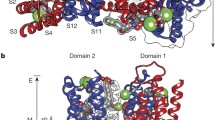Abstract
Two-pore channel proteins (TPC) encode intracellular ion channels in both animals and plants. In mammalian cells, the two isoforms (TPC1 and TPC2) localize to the endo-lysosomal compartment, whereas the plant TPC1 protein is targeted to the membrane surrounding the large lytic vacuole. Although it is well established that plant TPC1 channels activate in a voltage- and calcium-dependent manner in vitro, there is still debate on their activation under physiological conditions. Likewise, the mode of animal TPC activation is heavily disputed between two camps favoring as activator either nicotinic acid adenine dinucleotide phosphate (NAADP) or the phosphoinositide PI(3,5)P2. Here, we investigated TPC current responses to either of these second messengers by whole-vacuole patch-clamp experiments on isolated vacuoles of Arabidopsis thaliana. After expression in mesophyll protoplasts from Arabidopsis tpc1 knock-out plants, we detected the Arabidopsis TPC1-EGFP and human TPC2-EGFP fusion proteins at the membrane of the large central vacuole. Bath (cytosolic) application of either NAADP or PI(3,5)P2 did not affect the voltage- and calcium-dependent characteristics of AtTPC1-EGFP. By contrast, PI(3,5)P2 elicited large sodium currents in hTPC2-EGFP-containing vacuoles, while NAADP had no such effect. Analogous results were obtained when PI(3,5)P2 was applied to hTPC2 expressed in baker’s yeast giant vacuoles. Our results underscore the fundamental differences in the mode of current activation and ion selectivity between animal and plant TPC proteins and corroborate the PI(3,5)P2-mediated activation and Na+ selectivity of mammalian TPC2.





Similar content being viewed by others
Abbreviations
- EGFP:
-
Enhanced green fluorescent protein
- EGTA:
-
Ethylene glycol tetraacetic acid
- NAADP:
-
Nicotinic acid adenine dinucleotide phosphate
- PI(3,5)P2 :
-
Phosphatidylinositol-(3,5)-bisphosphate
- TPC:
-
Two-pore channel
- VM:
-
Vacuolar membrane
References
Yu FH, Yarov-Yarovoy V, Gutman GA, Catterall WA (2005) Overview of molecular relationships in the voltage-gated ion channel superfamily. Pharmacol Rev 57(4):387–395
Rietdorf K, Funnell TM, Ruas M, Heinemann J, Parrington J, Galione A (2011) Two-pore channels form homo- and heterodimers. J Biol Chem 286(43):37058–37062
Peiter E, Maathuis FJ, Mills LN, Knight H, Pelloux J, Hetherington AM, Sanders D (2005) The vacuolar Ca2+-activated channel TPC1 regulates germination and stomatal movement. Nature 434(7031):404–408
Ranf S, Wunnenberg P, Lee J, Becker D, Dunkel M, Hedrich R, Scheel D, Dietrich P (2008) Loss of the vacuolar cation channel, AtTPC1, does not impair Ca2+ signals induced by abiotic and biotic stresses. Plant J 53(2):287–299
Dadacz-Narloch B, Beyhl D, Larisch C, Lopez-Sanjurjo EJ, Reski R, Kuchitsu K, Muller TD, Becker D, Schonknecht G, Hedrich R (2011) A novel calcium binding site in the slow vacuolar cation channel TPC1 senses luminal calcium levels. Plant Cell 23(7):2696–2707
Hedrich R, Neher E (1987) Cytoplasmic calcium regulates voltage-dependent ion channels in plant vacuoles. Nature 329:833–835
Gambale F, Cantu AM, Carpaneto A, Keller BU (1993) Fast and slow activation of voltage-dependent ion channels in radish vacuoles. Biophys J 65(5):1837–1843
Allen GJ, Sanders D (1996) Control of ionic currents in guard cell vacuoles by cytosolic and luminal calcium. Plant J 10:1055–1069
Pottosin II, Dobrovinskaya OR, Muniz J (2001) Conduction of monovalent and divalent cations in the slow vacuolar channel. J Membrane Biol 181:55–65
Gradogna A, Scholz-Starke J, Gutla PV, Carpaneto A (2009) Fluorescence combined with excised patch: measuring calcium currents in plant cation channels. Plant J 58:175–182
Hedrich R, Marten I (2011) TPC1-SV channels gain shape. Mol Plant 4(3):428–441
Hedrich R (2012) Ion channels in plants. Physiol Rev 92(4):1777–1811
Schulze C, Sticht H, Meyerhoff P, Dietrich P (2011) Differential contribution of EF-hands to the Ca2+-dependent activation in the plant two-pore channel TPC1. Plant J 68(3):424–432
Rienmuller F, Beyhl D, Lautner S, Fromm J, Al-Rasheid KA, Ache P, Farmer EE, Marten I, Hedrich R (2010) Guard cell-specific calcium sensitivity of high density and activity SV/TPC1 channels. Plant Cell Physiol 51(9):1548–1554
Pei ZM, Ward JM, Schroeder JI (1999) Magnesium sensitizes slow vacuolar channels to physiological cytosolic calcium and inhibits fast vacuolar channels in fava bean guard cell vacuoles. Plant Physiol 121(3):977–986
Carpaneto A, Cantù AM, Gambale F (2001) Effects of cytoplasmic Mg2+ on slowly activating channels in isolated vacuoles of Beta vulgaris. Planta 213:457–468
Carpaneto A, Cantu AM, Gambale F (1999) Redox agents regulate ion channel activity in vacuoles from higher plant cells. FEBS Lett 442(2–3):129–132
Scholz-Starke J, De Angeli A, Ferraretto C, Paluzzi S, Gambale F, Carpaneto A (2004) Redox-dependent modulation of the carrot SV channel by cytosolic pH. FEBS Lett 576(3):449–454
Scholz-Starke J, Gambale F, Carpaneto A (2005) Modulation of plant ion channels by oxidizing and reducing agents. Arch Biochem Biophys 434(1):43–50
Scholz-Starke J, Carpaneto A, Gambale F (2006) On the interaction of neomycin with the slow vacuolar channel of Arabidopsis thaliana. J Gen Physiol 127(3):329–340
Gutla PVK, Boccaccio A, De Angeli A, Gambale F, Carpaneto A (2012) Modulation of plant TPC channels by polyunsaturated fatty acids. J Exp Bot 63(17):6187–6197
Calcraft PJ et al (2009) NAADP mobilizes calcium from acidic organelles through two-pore channels. Nature 459(7246):596–600
Guse AH, Lee HC (2008) NAADP: a universal Ca2+ trigger. Sci Signal 1(44):re10
Walseth TF, Lin-Moshier Y, Jain P, Ruas M, Parrington J, Galione A, Marchant JS, Slama JT (2012) Photoaffinity labeling of high affinity nicotinic acid adenine dinucleotide phosphate (NAADP)-binding proteins in sea urchin egg. J Biol Chem 287(4):2308–2315
Lin-Moshier Y, Walseth TF, Churamani D, Davidson SM, Slama JT, Hooper R, Brailoiu E, Patel S, Marchant JS (2012) Photoaffinity labeling of nicotinic acid adenine dinucleotide phosphate (NAADP) targets in mammalian cells. J Biol Chem 287(4):2296–2307
Morgan AJ, Galione A (2013) Two-pore channels (TPCs): current controversies. BioEssays 36(2):173–183
Pitt SJ, Funnell TM, Sitsapesan M, Venturi E, Rietdorf K, Ruas M, Ganesan A, Gosain R, Churchill GC, Zhu MX, Parrington J, Galione A, Sitsapesan R (2010) TPC2 is a novel NAADP-sensitive Ca2+release channel, operating as a dual sensor of luminal pH and Ca2+. J Biol Chem 285(45):35039–35046
Schieder M, Rotzer K, Bruggemann A, Biel M, Wahl-Schott CA (2010) Characterization of two-pore channel 2 (TPCN2)-mediated Ca2+currents in isolated lysosomes. J Biol Chem 285(28):21219–21222
Wang X, Zhang X, Dong XP, Samie M, Li X, Cheng X, Goschka A, Shen D, Zhou Y, Harlow J, Zhu MX, Clapham DE, Ren D, Xu H (2012) TPC proteins are phosphoinositide-activated sodium-selective ion channels in endosomes and lysosomes. Cell 151(2):372–383
Meijer HJ, Munnik T (2003) Phospholipid-based signaling in plants. Annu Rev Plant Biol 54:265–306
Heilmann I (2009) Using genetic tools to understand plant phosphoinositide signalling. Trends Plant Sci 14(3):171–179
Larisch N, Schulze C, Galione A, Dietrich P (2012) An N-terminal dileucine motif directs two-pore channels to the tonoplast of plant cells. Traffic 13(7):1012–1022
Costa A, Gutla PV, Boccaccio A, Scholz-Starke J, Festa M, Basso B, Zanardi I, Pusch M, Schiavo FL, Gambale F, Carpaneto A (2012) The Arabidopsis central vacuole as an expression system for intracellular transporters: functional characterization of the Cl−/H+exchanger CLC-7. J Physiol 590(Pt 15):3421–3430
Tzfira T, Tian GW, Lacroix B, Vyas S, Li J, Leitner-Dagan Y, Krichevsky A, Taylor T, Vainstein A, Citovsky V (2005) pSAT vectors: a modular series of plasmids for autofluorescent protein tagging and expression of multiple genes in plants. Plant Mol Biol 57(4):503–516
Yoo SD, Cho YH, Sheen J (2007) Arabidopsis mesophyll protoplasts: a versatile cell system for transient gene expression analysis. Nat Protoc 2(7):1565–1572
Abel S, Theologis A (1994) Transient transformation of Arabidopsis leaf protoplasts: a versatile experimental system to study gene expression. Plant J 5(3):421–427
Tanaka K, Nakafuku M, Tamanoi F, Kaziro Y, Matsumoto K, Toh-e A (1990) IRA2, a second gene of Saccharomyces cerevisiae that encodes a protein with a domain homologous to mammalian ras GTPase-activating protein. Mol Cell Biol 10(8):4303–4313
Rentsch D, Laloi M, Rouhara I, Schmelzer E, Delrot S, Frommer WB (1995) NTR1 encodes a high affinity oligopeptide transporter in Arabidopsis. FEBS Lett 370(3):264–268
Hamamoto S, Marui J, Matsuoka K, Higashi K, Igarashi K, Nakagawa T, Kuroda T, Mori Y, Murata Y, Nakanishi Y, Maeshima M, Yabe I, Uozumi N (2008) Characterization of a tobacco TPK-type K+ channel as a novel tonoplast K+ channel using yeast tonoplasts. J Biol Chem 283(4):1911–1920
Yabe I, Horiuchi K, Nakahara K, Hiyama T, Yamanaka T, Wang PC, Toda K, Hirata A, Ohsumi Y, Hirata R, Anraku Y, Kusaka I (1999) Patch clamp studies on V-type ATPase of vacuolar membrane of haploid Saccharomyces cerevisiae: preparation and utilization of a giant cell containing a giant vacuole. J Biol Chem 274(49):34903–34910
Nakanishi Y, Yabe I, Maeshima M (2003) Patch clamp analysis of a H+ pump heterologously expressed in giant yeast vacuoles. J Biochem 134(4):615–623
Brailoiu E, Churamani D, Cai X, Schrlau MG, Brailoiu GC, Gao X, Hooper R, Boulware MJ, Dun NJ, Marchant JS, Patel S (2009) Essential requirement for two-pore channel 1 in NAADP-mediated calcium signaling. J Cell Biol 186(2):201–209
Zhu MX, Ma J, Parrington J, Galione A, Evans AM (2010) TPCs: endolysosomal channels for Ca2+ mobilization from acidic organelles triggered by NAADP. FEBS Lett 584(10):1966–1974
Carpaneto A, Cantu AM, Busch H, Gambale F (1997) Ion channels in the vacuoles of the seagrass Posidonia oceanica. FEBS Lett 412(1):236–240
Ivashikina N, Hedrich R (2005) K+ currents through SV-type vacuolar channels are sensitive to elevated luminal sodium levels. Plant J 41(4):606–614
Acknowledgments
We thank Anna Moroni (University of Milan) for critical comments on the manuscript. The technical assistance of Francesca Quartino, Alessandro Barbin, Damiano Magliozzi (IBF-CNR, Italy) was highly appreciated. ACa was supported by the Italian “Progetti di Ricerca di Interesse Nazionale” (PRIN2010CSJX4F) and by Compagnia di San Paolo Research Foundation (ROL 291) and PD by the “Deutsche Forschungsgemeinschaft” (FOR964).
Author information
Authors and Affiliations
Corresponding author
Additional information
A. Boccaccio, J. Scholz-Starke, and S. Hamamoto contributed equally to this work.
Rights and permissions
About this article
Cite this article
Boccaccio, A., Scholz-Starke, J., Hamamoto, S. et al. The phosphoinositide PI(3,5)P2 mediates activation of mammalian but not plant TPC proteins: functional expression of endolysosomal channels in yeast and plant cells. Cell. Mol. Life Sci. 71, 4275–4283 (2014). https://doi.org/10.1007/s00018-014-1623-2
Received:
Revised:
Accepted:
Published:
Issue Date:
DOI: https://doi.org/10.1007/s00018-014-1623-2




